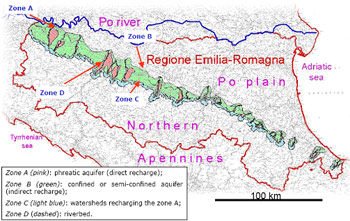GWPA identification and related measures in Italy
Background information
Title/Name of case study: Groundwater protected areas identification and measures enforcement in Italy: an example in the Emilia Romagna Region
Type of case study: Implementation of existing regulations in Italy
Documents:
- D.Lgs. 152/99 PDF, 283 kb (italian language)
- Guidelines for drinking water quality protection and improvement, 2002 (italian language)
Objective of case study: drinking water quality protection and improvement
Contribution to: Draft Guidance on the Groundwater aspects of Protected Areas under the Water Framework Directive
WFD focus: Protection of groundwater for human consumption.
Specific contributions: Safeguard zones and protected areas definitions.
Characterisation:
The Italian law presently in force (D.Lgs. 152/99, Art.21, paragraph 1) states that, in order to protect and improve the quality of groundwater resources intended for human consumption, Regions (Italian administrative units) must identify safeguard zones, on which measures and restrictions can be enforced in order to assure the protection of ground waters.
Characterisation Safeguard zones are divided into
1. "absolute guardianship zone" (an area of at least 10 m radius immediately surrounding the abstraction point),

2. "respect zone" (the territory surrounding the absolute guardianship zone, identified by a travel time 180 to 365 days, in relation to vulnerability and hazard conditions, or at least with a radius of 200 m from the abstraction point) and
3. "protection zones", identified within the groundwater recharge areas.
Figure 1: Drinking water protected areas in Emilia Romagna
Zone A (pink): phreatic aquifer (direct recharge);
Zone B (green): confined or semi-confined aquifer (indirect recharge)
Zone C (light blue): watersheds recharging the zone A;
Zone D (dashed): riverbed
The protection zone is defined on the ground of hydrogeological, hydrochemical and hydrological analysis; vulnerability to pollution is also taken into account. Specifically, springs protection zones correspond to the entire recharge area.Currently the "absolute guardianship zone" and the "respect zone" have already been delineated in most cases, while Regions are establishing protected areas. In few cases protected areas have been already identified and protection measures are in force. Among others, Emilia Romagna Region has identified the main ground water protected areas over 2850 km2 out of the 22,000 km2 (13%) of the entire administrative territory, subdivided into 4 sub-zones with different characteristics (Fig.1).
The Po river alluvial plain extends in the northern part of the Emilia Romagna region over 12,000 km2. Three different groundwater bodies have been recognised in this plain, among which the "Apennine river alluvial fans" could be considered as the priority groundwater bodies for chemical and quantitative features.
Fig.2-Location map and schematic cross section of the aquifers showing the protected areas for the "Apennine river alluvial fan" ground water body
Recharge areas are located along the southern margin, where the aquifers are unconfined; toward North they become multilayered and confined (Fig.2).Drinking water protected areas have been identified in the recharge areas as shown in Fig.1 and in the schematic cross section in Fig.2. Protection areas extend beyond the boundaries of the ground water body in order to include the impervious basins upstream of the fans that can indirectly contribute to the recharge of the aquifers (zone C in Fig.1).
Applied measures
The protection measures, organised in a Regional Plan, are different in relation to the characteristics of the zones of the protected areas (A, B, C, D in Fig.1). They concern agriculture and cattle breeding activities (manure spreading, fertilisers and pesticides use), quarrying activities, urbanisation (sewage networks, waterproofing), industrial activities (also in relation to quantitative aspects), landfill location. Hazardous activities in relation to water quality must be specifically authorised. Measures and rules have been discussed and modified through a participatory process in which public and private stakeholders (water companies, agriculture associations, industry representatives, environmental organisations and others) have been involved.
Pollution indicators (e.g. NO3) have been selected and monitoring activities have been undertaken in the protected areas in order to check the effectiveness of the adopted measures. The possibility of introducing corrective actions during the implementation of the Plan have been foreseen. Additional drinking water protected areas are being identified in the Region by other administrative boards for minor ground water bodies.
Experiences gained - Conclusions - Recommendations
The large involvement of stakeholders in the definition of measures and restrictions to be adopted has been a fundamental part in the implementation of protected areas, leading to the general acceptance of the plan. Other Regions in Italy are currently implementing the national regulations and are delineating areas for the protection of groundwater for human consumption. Measures to be applied and delineation procedures are in fact entrusted to Regions, whereas the general criteria and the objectives are established by the national legislation.

